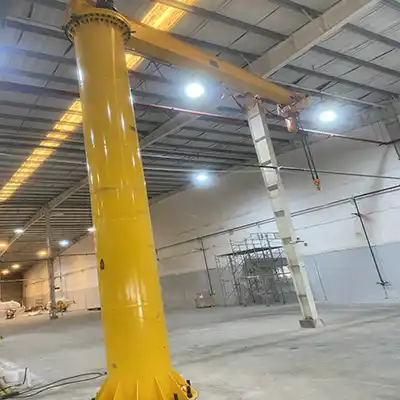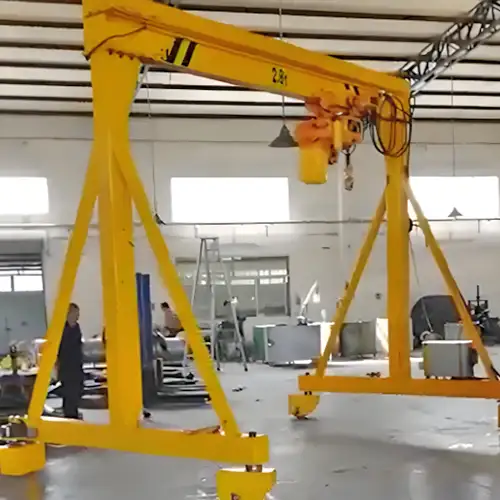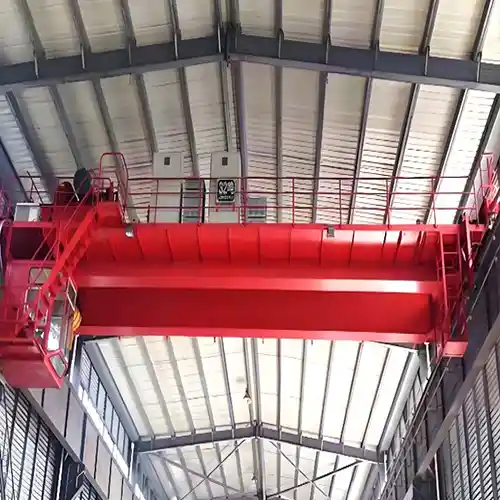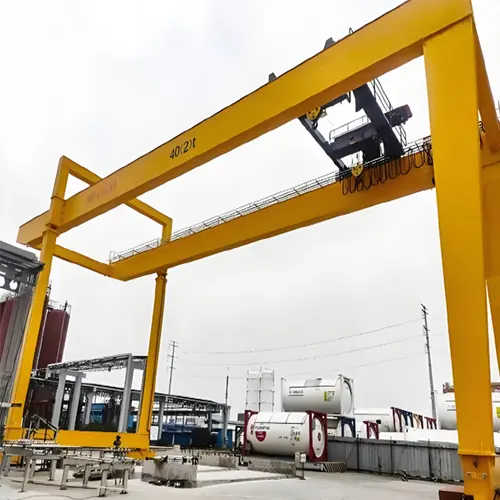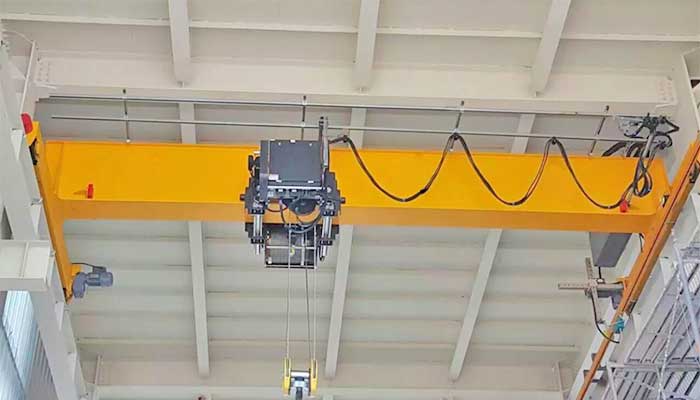
Bridge Cranes in Modern Animal Husbandry Enhancing Animal Welfare
Overhead cranes in modern animal husbandry improve efficiency of the movement of heavy materials, equipment & animals themselves.Get your bridge crane!
Animal husbandry
Animal husbandry refers to the branch of agriculture that involves the breeding, care, management, and production of domesticated animals, primarily for various purposes like food, fiber, labor, and companionship. It encompasses the practices and techniques used to raise and maintain animals in a controlled environment to ensure their well-being and maximum productivity.
Animal husbandry involves a range of activities, including:
- Breeding: Selective breeding is employed to develop and maintain specific traits in animals, such as improved meat or milk production, disease resistance, or specific physical characteristics.
- Feeding: Providing proper nutrition to animals is crucial for their growth, health, and productivity. Animal nutrition involves understanding their dietary requirements and formulating balanced diets.
- Healthcare: Regular monitoring of animal health, disease prevention, and veterinary care are essential aspects of animal husbandry. This involves vaccinations, parasite control, and disease management.
- Housing: Designing appropriate shelters and housing systems that offer protection from harsh weather conditions, predators, and stress is important for the animals' well-being.
- Reproduction: Managing the reproductive processes of animals to ensure controlled breeding, proper timing, and efficient reproduction cycles.
- Waste Management: Proper disposal of waste produced by animals, such as manure and urine, is important to prevent environmental pollution and maintain hygiene.
- Animal Welfare: Ethical and humane treatment of animals is a central concern in animal husbandry. Providing a comfortable and stress-free environment for animals is essential for their overall health and productivity.
- Economic Considerations: Animal husbandry is often practiced to achieve economic benefits. This can involve maximizing the yield of products like meat, milk, eggs, wool, and leather.
- Research and Innovation: Advances in genetics, nutrition, and technology have led to innovative practices in animal husbandry. Techniques like artificial insemination, embryo transfer, and precision farming have been developed to improve animal production and health.
Animal husbandry plays a significant role in ensuring a stable and sustainable supply of animal-derived products, which are essential for human consumption and various industries. However, there are ethical concerns associated with intensive animal farming practices, including issues related to animal welfare and environmental impact. Efforts are being made to balance the economic benefits of animal husbandry with the well-being of animals and the environment through practices such as organic farming, free-range systems, and sustainable agriculture.
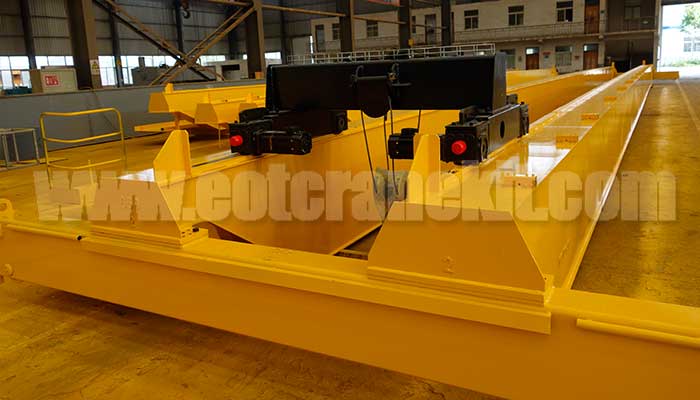
Overhead Cranes for Animal Husbandry
In the world of agriculture, technological advancements have revolutionized traditional practices, leading to more efficient and sustainable methods of animal farming. One such innovation that has significantly impacted modern animal husbandry is the use of overhead cranes. In this blog, we'll explore the definition of overhead cranes and delve into their pivotal role in revolutionizing the landscape of animal farming.
Definition of Overhead Cranes
Overhead cranes, also known as bridge cranes, are a type of material handling equipment characterized by their elevated structure that spans across a designated area. These cranes are equipped with a hoisting mechanism and trolley that move along the length of the bridge, allowing for the precise lifting, positioning, and transportation of heavy loads.
Importance of Overhead Cranes in Modern Animal Farming
Animal farming has evolved from traditional practices to more sophisticated and efficient methods. Overhead cranes have become an indispensable asset in this transformation, offering a range of benefits that contribute to improved operational efficiency, enhanced animal welfare, and overall productivity.
Modern animal farming involves large-scale operations that require the movement of heavy materials, equipment, and even animals themselves. This is where the versatility of overhead cranes shines. These cranes are adept at handling various tasks, from transporting feed to lifting heavy equipment for installation or maintenance.
Types of Overhead Cranes Used in Animal Husbandry
In the realm of animal husbandry, the deployment of overhead cranes has revolutionized how farming operations are conducted. Let's delve deeper into the three main types of overhead cranes utilized in animal husbandry, each tailored to address specific requirements and tasks within the industry.
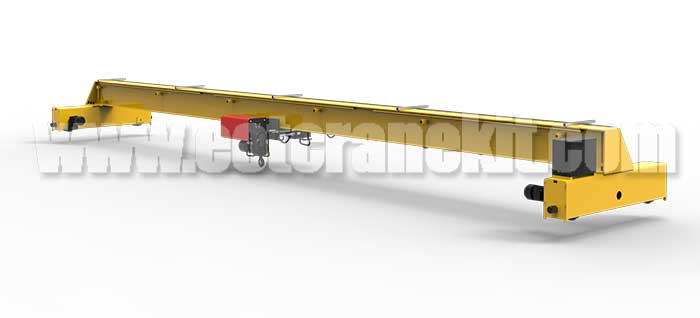
Single Girder Overhead Crane
Definition and Features
A single girder overhead crane is a versatile and cost-effective solution that boasts a simplified design. It consists of a single horizontal beam (girder) that supports the hoist and trolley mechanism, allowing smooth movement along the designated track.
Crane Capacity and Load Range
With a typical crane capacity ranging from to 5 tons, single girder cranes are well-suited for tasks involving lighter to moderate loads. These loads can include materials, equipment, and even feed within animal farming facilities.
Benefits and Advantages
- Cost-Effectiveness: Single girder cranes offer an economical choice for material handling needs, ideal for agricultural settings.
- Space Optimization: Their compact design optimizes available space, making them suitable for facilities with limited areas.
- Efficient Lifting: These cranes efficiently move loads within the designated area, enhancing productivity.
Functions and Applications in Animal Husbandry
Single girder overhead cranes find their utility in several key functions within animal husbandry:
- Feed Distribution: These cranes streamline the movement of feed bags from storage to feeding stations, ensuring animals are well-nourished.
- Equipment Installation and Maintenance: Single girder cranes facilitate the installation and maintenance of essential equipment, aiding in seamless operations.
- Material Storage and Organization: They assist in efficient storage of supplies and equipment, contributing to an organized facility.
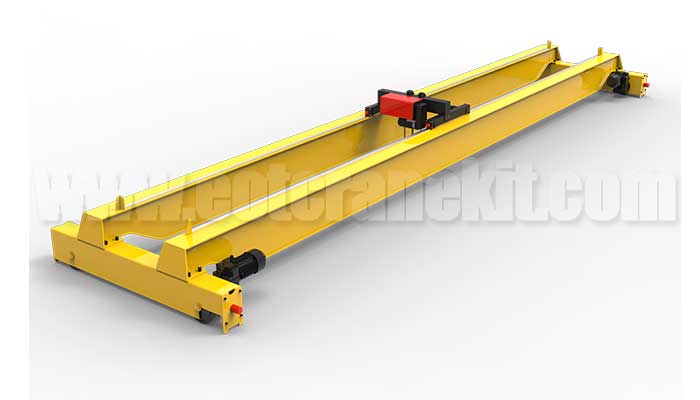
Double Girder Overhead Crane
Definition and Features
A double girder overhead crane, distinguished by its two parallel horizontal beams (girders), offers enhanced load-carrying capacity and robustness. This type of crane is designed to tackle heavier loads and more demanding tasks.
Crane Capacity and Load Range
With a crane capacity ranging from 5 to 20 tons, double girder cranes are built to handle substantial weights. This capacity makes them indispensable in larger-scale animal farming facilities.
Benefits and Advantages
- High Load-Carrying Capacity: Double girder cranes excel in lifting and transporting heavy equipment and materials, supporting diverse tasks.
- Durability: Engineered for intensive usage, these cranes withstand rigorous demands and challenging environments.
- Versatility: Double girder cranes accommodate a wide range of applications that involve heavy lifting and positioning.
Functions and Applications in Animal Husbandry
- Double girder overhead cranes play a crucial role in various functions that require strength and reliability:
- Moving Heavy Loads: These cranes efficiently transport heavy materials like hay, straw, and bedding, simplifying logistics.
- Emergency Situations: In times of crisis, double girder cranes aid in safely relocating animals to secure areas, ensuring their well-being.
- Equipment Installation and Maintenance: They contribute to the installation and upkeep of heavy equipment, enhancing operational readiness.
Customized Cranes with Special Attachments
Purpose of Customization
Customized cranes with special attachments offer tailored solutions to address unique challenges and tasks within animal husbandry. These attachments are designed to optimize animal handling procedures and support specialized requirements.
Tailoring Cranes for Specific Animal Handling or Tasks
By incorporating attachments such as slings, hooks, or platforms, customized cranes can be adapted to suit specific animal handling tasks, minimizing stress and ensuring safety.
Benefits and Applications
- Precision and Adaptability: Customized cranes enable precise handling of animals and materials, enhancing accuracy and reducing errors.
- Enhanced Safety: Attachments are designed with animal welfare in mind, minimizing discomfort and stress during lifting and transportation.
- Efficiency: Custom attachments streamline processes, leading to increased efficiency in daily operations.
Customized cranes with special attachments are integral to specific applications within animal husbandry:
- Handling Large Animals: These cranes ensure the safe and stress-free handling of larger animals during veterinary procedures.
- Transportation of Animals: Customized attachments facilitate the transportation of animals within the facility, minimizing stress and disruption.
- Specialized Equipment Requirements: Cranes with attachments can be tailored to meet unique equipment installation or maintenance needs.
The deployment of single girder, double girder, and customized cranes with special attachments underscores the adaptability and innovation that modern animal husbandry embraces. By selecting the appropriate crane type, animal farming facilities can streamline processes, enhance efficiency, and prioritize the well-being of their animals.
Features and Benefits of Overhead Cranes in Animal Husbandry
As the agricultural landscape evolves, the integration of advanced technologies becomes paramount. Overhead cranes, with their exceptional features and benefits, have become pivotal tools in revolutionizing animal husbandry practices. Let's explore the robust features and the myriad benefits these cranes bring to the table.
Features
Hoisting Mechanism
The heart of any overhead crane, the hoisting mechanism, allows for vertical movement of loads. This mechanism ensures precision lifting and lowering, critical for tasks ranging from transporting feed to installing heavy equipment.
Bridge Structure
The bridge structure forms the foundation of the crane's design. It provides the necessary support for the hoist and trolley, enabling smooth movement along the designated track. The sturdiness of the bridge structure guarantees the safe and efficient operation of the crane.
Trolley Movement
The trolley mechanism enables the horizontal movement of the hoist along the bridge. This feature offers pinpoint accuracy when positioning loads, making tasks such as feed distribution and equipment installation more efficient.
Control Systems
Modern overhead cranes come equipped with advanced control systems that simplify operation. These systems allow operators to maneuver the crane smoothly and precisely, ensuring accurate load placement and minimizing the risk of accidents.
Safety Features
Safety takes center stage in animal husbandry operations. Overhead cranes are integrated with a range of safety features, including limit switches, overload protection, emergency stop buttons, and collision avoidance systems. These features not only safeguard operators but also prioritize the welfare of animals.
Benefits
Enhanced Operational Efficiency
Efficiency is the cornerstone of successful animal farming. Overhead cranes expedite material handling tasks, reducing the time and effort required to move heavy loads. This efficiency translates to optimized workflows and increased productivity.
Reduced Manual Labor
Manual labor can be physically demanding and time-consuming. By replacing manual lifting and moving with the use of overhead cranes, the burden on workers is significantly reduced. This reduction in labor-intensive tasks contributes to the well-being of employees.
Improved Animal Welfare
The welfare of animals is a top priority in modern animal farming. Overhead cranes play a crucial role in minimizing stress and discomfort during tasks such as animal handling or transportation. Customized attachments ensure gentle and safe procedures that enhance the overall well-being of animals.
Versatility for Various Tasks
Animal husbandry involves a diverse range of tasks, from feed distribution to equipment installation. Overhead cranes, with their adaptability, are versatile tools that can be tailored to suit a variety of functions. This versatility allows for seamless transitions between different tasks, streamlining operations.
Incorporating overhead cranes into animal husbandry operations introduces a new era of efficiency, safety, and animal care. The amalgamation of advanced features and benefits not only drives productivity but also showcases the commitment of the industry to embracing cutting-edge technologies for the betterment of animal farming practices. By selecting the right type of crane and harnessing its features, animal farming facilities can elevate their operations to new heights.
Functions and Applications in Animal Husbandry
The adoption of overhead cranes has brought a transformative shift in the dynamics of animal husbandry. These versatile tools have found their niche in various functions, revolutionizing the way tasks are performed within the industry. Let's explore the wide spectrum of functions and applications where overhead cranes play a pivotal role in enhancing efficiency and animal well-being.
Feed Distribution:
In large-scale animal farming operations, heavy bags of feed or fodder might need to be transported from storage areas to different sections of the facility. Overhead cranes could assist in lifting and moving these bags efficiently, reducing the manual labor required.
- Typical Crane Type: Single Girder Overhead Crane
- Crane Capacity: to 5 tons
- Features: Cost-effective, requires less space, suitable for lighter loads.
- Benefits: Efficiently moves feed bags from storage to feeding stations.
- Functions: Lifts and moves bags of feed between storage areas and feeding stations, reducing manual labor and streamlining the feeding process.
Equipment Installation and Maintenance:
Overhead cranes can be used to install or replace heavy equipment, such as feeding systems, ventilation units, and water supply systems. They can also assist in maintenance tasks, lifting and positioning equipment for repairs or upgrades.
- Typical Crane Type: Double Girder Overhead Crane
- Crane Capacity: 5 to 20 tons
- Features: Higher load-carrying capacity, suitable for heavy loads and more intense usage.
- Benefits: Facilitates installation and maintenance of heavy equipment.
- Functions: Lifts and positions heavy equipment, such as feeding systems or ventilation units, for installation, repair, or replacement.
Animal Housing Construction:
During the construction of new animal housing structures or renovation of existing ones, overhead cranes can help move and position construction materials like steel beams, roofing materials, and panels.
- Typical Crane Type: Single Girder Overhead Crane
- Crane Capacity: to 10 tons
- Features: Cost-effective, suitable for moderate loads and spans.
- Benefits: Assists in moving construction materials during facility expansion or renovation.
- Functions: Lifts and moves construction materials like steel beams, roofing materials, and panels for the construction or renovation of animal housing structures.
Waste Management:
Overhead cranes might be used to lift and transport waste bins or containers containing manure and other waste materials, facilitating their removal from animal housing areas.
- Typical Crane Type: Single Girder Overhead Crane
- Crane Capacity: to 5 tons
- Features: Cost-effective, suitable for moderate loads.
- Benefits: Facilitates removal of waste materials from animal housing areas.
- Functions: Lifts and transports waste bins or containers containing waste materials for proper disposal.
Handling Large Animals:
In certain cases, overhead cranes could be designed to handle larger animals for specific procedures such as veterinary examinations, treatments, or transportation within the facility.
- Typical Crane Type: Customized Crane with Special Attachments
- Crane Capacity: Customized based on animal weight and requirements
- Features: Designed for specific animal-handling requirements.
- Benefits: Reduces stress on animals during veterinary procedures or transportation.
- Functions: Lifts and moves larger animals as needed for veterinary examinations, treatments, or transportation within the facility.
Moving Heavy Loads:
Apart from feed and equipment, overhead cranes can be used to move heavy loads of materials like hay, straw, or bedding material between storage areas and animal housing.
- Typical Crane Type: Single Girder Overhead Crane
- Crane Capacity: to 10 tons
- Features: Cost-effective, suitable for moderate loads.
- Benefits: Efficiently moves heavy materials like hay, straw, or bedding.
- Functions: Lifts and moves heavy loads of materials between storage areas and animal housing.
Material Storage and Organization:
Overhead cranes can help with the organization of storage areas by lifting and positioning pallets of supplies or equipment in a way that maximizes available space.
- Typical Crane Type: Single Girder Overhead Crane
- Crane Capacity: to 5 tons
- Features: Cost-effective, suitable for moderate loads.
- Benefits: Organizes storage areas efficiently by lifting and positioning pallets of supplies.
- Functions: Lifts and places pallets of supplies or equipment to maximize storage space.
Emergency Situations:
In emergency situations, such as the need to rescue or relocate animals due to natural disasters or disease outbreaks, overhead cranes could assist in the safe and efficient movement of animals.
- Typical Crane Type: Double Girder Overhead Crane
- Crane Capacity: 5 to 20 tons
- Features: Higher load-carrying capacity for emergency situations.
- Benefits: Assists in the safe and efficient relocation of animals during emergencies.
- Functions: Lifts and moves animals to designated safe areas in case of natural disasters or disease outbreaks.
Transportation of Animals:
In some advanced facilities, overhead cranes might be utilized to move animals from one section of the facility to another, minimizing stress on the animals and reducing the need for physical handling.
- Typical Crane Type: Customized Crane with Special Animal Containers
- Crane Capacity: Customized based on animal weight and requirements
- Features: Designed with animal welfare considerations.
- Benefits: Reduces stress on animals during transportation within the facility.
- Functions: Lifts and moves animals from one section of the facility to another, minimizing the need for physical handling.
Automated Feeding Systems:
Overhead cranes can be integrated into automated feeding systems, lifting and moving containers of feed to designated feeding stations within the facility.
- Typical Crane Type: Single Girder Overhead Crane
- Crane Capacity: to 5 tons
- Features: Cost-effective, suitable for lighter loads.
- Benefits: Integrates with automated feeding systems for efficient feed distribution.
- Functions: Lifts and moves containers of feed to designated feeding stations within the facility.
Temperature Control:
Overhead cranes could help in positioning and adjusting thermal curtains or insulation materials to regulate the temperature within animal housing areas.
- Typical Crane Type: Single Girder Overhead Crane
- Crane Capacity: to 5 tons
- Features: Cost-effective, suitable for lighter loads.
- Benefits: Helps regulate temperature within animal housing areas.
- Functions: Lifts and positions thermal curtains or insulation materials to manage temperature.
It's important to note that the use of overhead cranes in animal farming requires careful consideration of safety, animal welfare, and operational efficiency. Cranes should be operated by trained personnel, and the design and layout of the facility should account for the movement of heavy loads and equipment to ensure the well-being of both animals and workers.
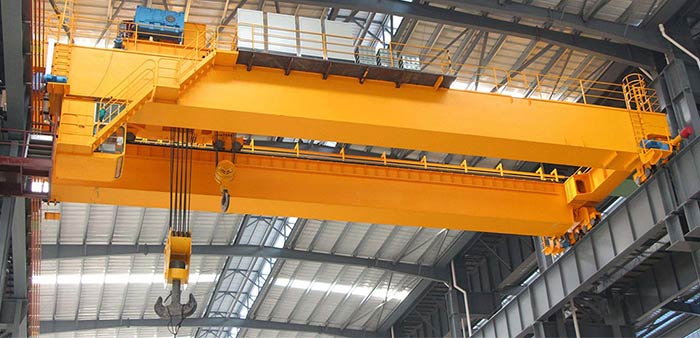
Animal husbandry Industrial requirement for overhead cranes
While overhead cranes are not commonly associated with traditional animal husbandry practices, certain specialized and modernized animal farming facilities might have industrial requirements that could necessitate the use of overhead cranes. These requirements may arise in larger-scale operations where efficiency, automation, and equipment assistance are essential. Here are some potential industrial requirements for overhead cranes in such contexts:
- Large-Scale Feed Distribution: In facilities with a significant number of animals, efficient distribution of feed becomes crucial. Overhead cranes could assist in moving and distributing large quantities of feed quickly and accurately.
- Automated Feeding Systems: Overhead cranes can be integrated into automated feeding systems, ensuring that feed containers are lifted and positioned accurately at designated feeding stations.
- Maintenance and Equipment Handling: Animal farming facilities often use specialized equipment for feeding, ventilation, and waste management. Overhead cranes could assist in installation, maintenance, and replacement of such equipment.
- Construction and Expansion: During the construction or expansion of animal housing structures or facilities, overhead cranes can help with the movement and positioning of heavy construction materials.
- Handling Large Animals: In specialized animal husbandry operations, the need to handle larger animals for medical procedures or transportation might arise. Overhead cranes could provide a safe and efficient solution.
- Waste Management and Manure Removal: Overhead cranes can assist in lifting and transporting waste bins or containers, streamlining waste management and maintaining cleanliness.
- Emergency Preparedness: In case of emergencies such as disease outbreaks or natural disasters, overhead cranes could be used to efficiently move and relocate animals to designated safe areas.
- Efficient Material Handling: Overhead cranes can enhance the efficiency of material storage, organization, and movement within the facility.
- Temperature Control: Overhead cranes might be utilized for positioning thermal curtains or insulation materials to regulate temperature within animal housing areas.
- Transportation of Animals: In facilities with intricate layouts, overhead cranes could be used to move animals between different sections of the facility, reducing the need for physical handling.
- High-Volume Production: Facilities focusing on high-volume animal production might require equipment assistance, including overhead cranes, to manage the scale of operations efficiently.
- Advanced Facilities: Modern animal farming facilities might incorporate advanced technologies and systems, where overhead cranes could play a role in optimizing various processes.
It's important to emphasize that the use of overhead cranes in animal husbandry should be carefully evaluated based on factors such as facility size, operation scale, animal welfare considerations, safety protocols, and economic viability. Any decision to integrate overhead cranes should align with the goals of improving efficiency, maintaining animal welfare, and adhering to relevant regulations.
Considerations and Safety Measures
The integration of overhead cranes into animal husbandry operations brings forth a host of advantages, but it also entails a responsibility to ensure the well-being of both workers and animals. Safeguarding all aspects of the operation, from proper training to adherence to safety regulations, is paramount to a successful and ethical implementation.
A. Proper Training for Crane Operators
Ensuring that crane operators are adequately trained is a foundational requirement. Operators should possess the necessary knowledge and skills to maneuver the crane safely, handle animals with care, and perform tasks effectively. Regular training and certification programs ensure that operators remain proficient and up-to-date with best practices.
B. Adhering to Animal Welfare Standards
Animal welfare is a cornerstone of ethical animal husbandry practices. When incorporating overhead cranes, it's crucial to prioritize the comfort, safety, and psychological well-being of animals. This involves using appropriate attachments, minimizing stress during lifting and transportation, and following established guidelines for humane animal handling.
C. Facility Layout and Design Considerations
The layout and design of the facility play a pivotal role in maximizing the benefits of overhead cranes. Properly positioned tracks, ample clearance, and designated areas for crane operation contribute to the seamless movement of loads and the safe transportation of animals.
D. Regular Maintenance and Inspection of Cranes
Just like any piece of machinery, overhead cranes require regular maintenance and inspection to ensure optimal performance. Routine checks of hoisting mechanisms, control systems, and safety features help identify and rectify potential issues before they escalate.
E. Compliance with Safety Regulations
Regulatory compliance is non-negotiable when it comes to the operation of overhead cranes in animal farming. Adhering to industry-specific safety standards and regulations not only ensures the well-being of workers and animals but also avoids potential legal repercussions.
By diligently considering these aspects and implementing robust safety measures, animal farming facilities can harness the full potential of overhead cranes while upholding their commitment to the welfare of both animals and humans. Striking a balance between operational efficiency and ethical practices paves the way for a progressive and responsible approach to modern animal husbandry.
Bridge crane application to related sectors
Animal husbandry is closely related to several sectors and industries that contribute to the overall agricultural and food production landscape. These related sectors often work in conjunction with animal husbandry practices to ensure the efficient and sustainable production of animal-derived products. Some of the key related sectors include:
Agriculture:
Animal husbandry is a subset of agriculture. The two sectors are closely linked as they both involve cultivating crops and raising animals for various purposes, including food production, fiber, and other agricultural products.
- Typical Crane Type: Single Girder Overhead Crane
- Crane Capacity: to 5 tons
- Features: Cost-effective, requires less space, suitable for light to moderate loads.
- Benefits: Efficient handling of materials and equipment within agricultural facilities.
- Functions: Assists in moving agricultural supplies, equipment, and materials for planting, maintenance, and harvesting.
Dairy Farming:
Dairy farming involves the breeding and management of dairy animals, primarily cows, goats, and sheep, for the production of milk and dairy products such as cheese, butter, and yogurt.
- Typical Crane Type: Single Girder Overhead Crane
- Crane Capacity: to 5 tons
- Features: Cost-effective, suitable for light to moderate loads.
- Benefits: Helps move feed, equipment, and materials efficiently within the dairy facility.
- Functions: Lifts and positions feed bags, milking equipment, and maintenance tools.
Poultry Farming:
Poultry farming focuses on the raising of chickens, ducks, turkeys, and other birds for their meat and eggs. This sector plays a vital role in providing protein-rich food sources.
- Typical Crane Type: Single Girder Overhead Crane
- Crane Capacity: to 5 tons
- Features: Cost-effective, suitable for light loads.
- Benefits: Assists in moving feed, equipment, and materials in poultry houses.
- Functions: Lifts and positions feed containers, water dispensers, and maintenance tools.
Livestock Farming:
Livestock farming encompasses the raising of animals like cattle, pigs, sheep, and goats for meat (such as beef, pork, lamb, and mutton) and other animal-derived products.
- Typical Crane Type: Single Girder Overhead Crane
- Crane Capacity: to 5 tons
- Features: Cost-effective, suitable for light to moderate loads.
- Benefits: Facilitates the movement of feed, equipment, and materials in livestock facilities.
- Functions: Lifts and moves feed bins, bedding materials, and maintenance equipment.
Aquaculture:
Aquaculture involves the farming of aquatic organisms, such as fish, shrimp, and shellfish, in controlled environments. It provides a significant source of protein for human consumption.
- Typical Crane Type: Single Girder Overhead Crane
- Crane Capacity: to 5 tons
- Features: Cost-effective, suitable for light to moderate loads.
- Benefits: Assists in moving equipment and materials within aquaculture facilities.
- Functions: Lifts and positions fish feed containers, water circulation equipment, and maintenance tools.
Feed Production:
The production of animal feed is essential for sustaining livestock and poultry populations. This sector involves the cultivation, processing, and formulation of feeds that provide essential nutrients to animals.
- Typical Crane Type: Single Girder Overhead Crane
- Crane Capacity: to 5 tons
- Features: Cost-effective, suitable for light to moderate loads.
- Benefits: Efficiently moves raw materials and finished feed products within the feed production facility.
- Functions: Lifts and positions bags of raw ingredients, moves feed between processing stages.
Agribusiness and Agricultural Technology:
Companies and technologies that support animal husbandry operations, such as equipment manufacturers, feed producers, genetics companies, and agribusiness service providers, play a critical role in modern animal farming practices.
- Typical Crane Type: Double Girder Overhead Crane
- Crane Capacity: 5 to 20 tons
- Features: Higher load-carrying capacity, suitable for heavy loads and intense usage.
- Benefits: Facilitates the movement of heavy equipment and supplies in agribusiness operations.
- Functions: Lifts and positions equipment for maintenance, moves large supplies.
Veterinary Medicine:
Veterinary professionals are essential for ensuring the health and well-being of animals in animal husbandry operations. They provide medical care, disease prevention, and health management services.
- Typical Crane Type: Single Girder Overhead Crane
- Crane Capacity: to 5 tons
- Features: Cost-effective, suitable for light to moderate loads.
- Benefits: Assists in moving medical equipment and supplies within veterinary clinics or hospitals.
- Functions: Lifts and positions medical instruments, facilitates patient care.
Food Processing:
The animal products obtained through husbandry, such as meat, milk, and eggs, are often processed into various food products for human consumption. Food processing industries include meat processing, dairy processing, and egg processing.
- Typical Crane Type: Double Girder Overhead Crane
- Crane Capacity: 5 to 20 tons
- Features: Higher load-carrying capacity, suitable for heavy loads and intense usage.
- Benefits: Facilitates the movement of heavy processing equipment and materials in meat and dairy processing plants.
- Functions: Lifts and positions large processing machinery, moves product containers.
Biotechnology and Genetics:
Advances in biotechnology and genetics play a role in improving the quality and productivity of animal breeds through selective breeding, genetic engineering, and cloning.
- Typical Crane Type: Single Girder Overhead Crane
- Crane Capacity: to 5 tons
- Features: Cost-effective, suitable for light to moderate loads.
- Benefits: Assists in moving lab equipment and supplies within biotechnology facilities.
- Functions: Lifts and positions lab equipment, moves samples for testing.
Environmental Sustainability:
As animal husbandry practices can impact the environment, sectors focused on sustainability and environmental conservation collaborate to mitigate potential negative effects and promote sustainable practices.
- Typical Crane Type: Single Girder Overhead Crane
- Crane Capacity: to 5 tons
- Features: Cost-effective, suitable for light to moderate loads.
- Benefits: Helps move equipment and materials for environmental conservation efforts.
- Functions: Lifts and positions materials for waste management or sustainability projects.
Regulatory and Food Safety Authorities:
Regulatory agencies oversee animal husbandry operations to ensure compliance with safety, health, and animal welfare standards, thereby ensuring the safety and quality of animal-derived products for consumers.
- Typical Crane Type: Single Girder Overhead Crane
- Crane Capacity: to 5 tons
- Features: Cost-effective, suitable for light to moderate loads.
- Benefits: Assists in moving equipment and materials in regulatory and inspection facilities.
- Functions: Lifts and positions inspection equipment, moves samples for testing.
Research and Education:
Academic institutions and research organizations contribute to the advancement of knowledge and technology in animal husbandry, leading to improvements in breeding, nutrition, disease management, and animal welfare.
- Typical Crane Type: Single Girder Overhead Crane
- Crane Capacity: to 5 tons
- Features: Cost-effective, suitable for light to moderate loads.
- Benefits: Helps move laboratory equipment and educational materials within research institutions.
- Functions: Lifts and positions scientific instruments, moves educational resources.
Retail and Consumer Markets:
Animal products derived from husbandry, such as meat, eggs, and dairy, are distributed and sold through retail markets to consumers for consumption.
- Typical Crane Type: Single Girder Overhead Crane
- Crane Capacity: to 5 tons
- Features: Cost-effective, suitable for light loads.
- Benefits: Assists in moving and organizing products within retail and distribution centers.
- Functions: Lifts and positions product pallets, aids in inventory management.
Please keep in mind that the specific crane capacities mentioned are approximate ranges and may vary based on the unique requirements of each application within the mentioned sectors. The selection of crane capacity should consider factors such as the weight of the loads being lifted, the frequency of use, safety considerations, and any regulatory standards that apply. If you you have need, please contact professional overhead crane suppliers.
FAQs about Overhead Cranes in Animal Husbandry
As the integration of overhead cranes in animal husbandry becomes more prevalent, questions arise regarding their benefits, safety considerations, and practical applications. Here are answers to some frequently asked questions that shed light on the role of overhead cranes in the industry:
A. What are the main benefits of using overhead cranes in animal husbandry?
Overhead cranes offer numerous benefits, including enhanced operational efficiency, reduced manual labor, improved animal welfare, and versatility in performing various tasks. These cranes streamline processes, increase productivity, and prioritize the well-being of both animals and workers.
B. How can overhead cranes improve the efficiency of feed distribution?
Overhead cranes expedite the movement of feed bags from storage to feeding stations. By accurately and swiftly distributing feed, these cranes ensure that animals receive their nourishment on time, contributing to their health and growth.
C. Are there safety concerns when using overhead cranes around animals?
While overhead cranes can significantly improve operations, safety considerations are essential when working around animals. Specialized attachments, proper operator training, and adherence to animal welfare guidelines help minimize stress on animals and ensure their safety during lifting and transportation.
D. What factors should be considered when selecting the right crane capacity?
Choosing the appropriate crane capacity depends on the nature of the tasks and the weight of loads typically handled. Factors such as load range, equipment dimensions, and facility layout should all be taken into account to ensure the crane's capacity aligns with operational requirements.
E. How can overhead cranes assist in emergency situations in animal farming?
During emergencies such as natural disasters or facility incidents, overhead cranes play a vital role in swiftly relocating animals to safe areas. Their ability to gently and efficiently move animals ensures their well-being during critical times.
F. Can overhead cranes be integrated with automated feeding systems?
Absolutely. Overhead cranes can be seamlessly integrated with automated feeding systems. These cranes can precisely position feed containers within automated processes, ensuring accurate and timely distribution, reducing manual labor, and maintaining a consistent feeding schedule.
G. What role do specialized attachments play in customized cranes for animal handling?
Specialized attachments are integral components of customized cranes. They are designed to cater to specific animal handling tasks, such as gentle lifting during veterinary procedures. These attachments prioritize the comfort and well-being of animals, making handling procedures stress-free and safe.
H. Are there any specific guidelines for crane operator training in animal farming facilities?
Crane operator training is crucial for safe and efficient crane operation. Operators should undergo training programs that cover crane operation, animal handling protocols, and safety measures specific to animal farming. Regular refresher courses ensure operators remain proficient and updated on best practices.
By addressing these common questions, animal farming facilities can gain a comprehensive understanding of how overhead cranes can positively impact their operations. Implementing these solutions and insights ensures a smoother transition to utilizing this advanced technology while maintaining high standards of safety and animal welfare.
Conclusion
The realm of animal husbandry is undergoing a remarkable transformation, driven by technological innovations that are reshaping traditional practices. Overhead cranes have emerged as game-changers, ushering in a new era of efficiency, welfare, and safety in the industry. As we conclude this exploration of overhead cranes in animal husbandry, let's recap their significance and the remarkable benefits they bring to the table.
Incorporating overhead cranes into modern animal farming operations isn't just about lifting heavy loads; it's about redefining how tasks are performed, animals are cared for, and resources are optimized. These cranes have proven to be versatile tools that excel in a multitude of functions, from precise feed distribution to the safe and stress-free handling of animals during veterinary procedures.
The benefits are manifold. Enhanced operational efficiency translates into streamlined workflows and increased productivity. Reduced manual labor eases the physical demands on workers while ensuring optimal animal welfare remains a priority. The adaptability and versatility of overhead cranes enable them to seamlessly transition between various tasks, catering to the dynamic nature of animal farming.
Moreover, as we forge ahead with technological advancements, safety remains paramount. Proper training for crane operators, adherence to animal welfare standards, and meticulous facility design considerations are vital to ensure the well-being of both human and animal counterparts. Regular maintenance, coupled with compliance to safety regulations, ensures the continued functionality and reliability of overhead cranes.
In essence, overhead cranes have transcended their utilitarian role to become catalysts of progress and compassion in animal husbandry. By harnessing their features, benefits, and applications, the industry can achieve a harmonious blend of efficiency, animal welfare, and operational safety. As we continue to push the boundaries of what's possible, one thing remains clear: the journey toward a more advanced and compassionate animal farming industry is well underway.
